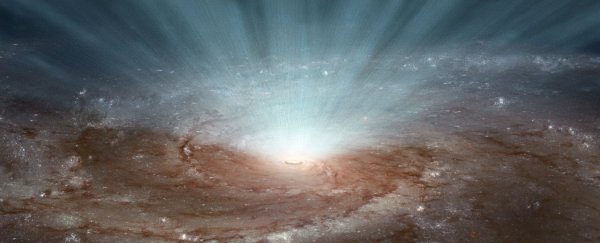A supermassive black hole at the centre of the PDS 456 galaxy has been caught belching up gusts of gas so strong, they could halt star formation and stunt the growth of the entire galaxy.
The discovery was made by an international team of astronomers that used the European Space Agency's (ESA) XMM-Newton telescope, and NASA's NuSTAR telescope, to watch the activity of this colossal cosmic object that lies two billion light-years away from Earth, and boasts a mass of no less than a billion Suns. For comparison, the black hole at the centre of our Milky Way galaxy has 'just' 4.3 million times the mass of the Sun.
While black hole winds - known as Ultra Fast Out-flows, or UFOs - are nothing new, the researchers managed to observe them blasting from the centre of the galaxy in every direction for the first time, before transforming into a strange, massive bubble. To help them figure out the strength and movements of the winds, NuSTAR was able to record high-energy X-ray images of the event, while XMM-Newton captured the low-energy X-rays.
"It tells us that the shape of the wind is not just a narrow beam pointed in our direction. It is really a wind that is flowing in every direction away from the black hole," lead author Emanuele Nardini, from Keele University in the UK, told Calla Cofield at Space.com. "With a spherical wind, the amount of mass it carries out is much larger than just a narrow beam."
The results have been published in the current edition of Science.
Black hole PDS 456 is something of a monster. It eats up all kinds of gas and dust particles that surround it, and when they're swallowed up by the enormous sinkhole, they radiate a stunning amount of light - more than any star in the surrounding galaxy. With its super-bright centre emitting all kinds of different types of light, this young galaxy is known as a quasar. This particular quasar has been imaged on five separate occasions through 2013 and 2014.
The two telescopes worked in tandem to give scientists the best picture of what's happening with the black hole, with XMM-Newton picking up on the iron atoms carried by its enormous gusts, and NuSTAR showing that these atoms were scattered to every side of its gaping maw.
"It's really astonishing that this supermassive black hole, no bigger than our Solar System, is so powerful that it influences an entire galaxy," NuSTAR's principal investigator, Fiona Harrison at the the California Institute of Technology in the US, told Stuart Gary at ABC Science. "It's amazing when you think about it."
I'm still getting over the idea of a 'small' black hole being the size of our entire Solar System.
Harrison and her colleagues now think they have a technique for figuring out the speed, shape and size of the black hole winds, so they can determine how big they are.
The sheer power thrown up by this black hole - scientists measured the speed of the winds blasting from it to be around one-third of the speed of light, and the X-rays they produced carried more energy than a trillion Suns - suggests it has the capacity to influence the evolution of the entire galaxy around it. This is because they blast away star-forming gasses, and so rob a galaxy of the raw materials it needs to grow. And scientists now think this is also the case for other supermassive black holes, according to BBC News, including the Sagittarius A supermassive black hole at the centre of the Milky Way.
"Now we know that quasar winds significantly contribute to mass loss in a galaxy, driving out its supply of gas, which is fuel for star formation," Nardini told the BBC. "This study provides a unique view of the possible mechanism that links the evolution of the central black holes to that of their host galaxies, over cosmic time."
Sources: BBC News, ABC Science, Space.com
